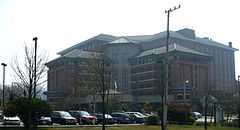Dragon Hill Lodge
| Dragon Hill Lodge | |
|---|---|
 | |
 | |
| General information | |
| Location | Seoul, South Korea |
| Coordinates | 37°31′55″N 126°58′54″E / 37.531833°N 126.981553°ECoordinates: 37°31′55″N 126°58′54″E / 37.531833°N 126.981553°E |
| Management | United States Department of Defense |
| Other information | |
| Number of rooms | 394 |
| Number of restaurants | 3 |
Dragon Hill Lodge is a U.S. Department of Defense - owned hotel in Seoul, South Korea. It is co-located with and is a part of the Yongsan Garrison (which mean "Dragon Mountain" in Korean) military community.
The Lodge is an Armed Forces Recreation Center (AFRC) resort hotel and serves thousands of guests each year, all of whom are required to be active or retired military, DOD employees, or their family members. The Lodge was built completely with soldier-dollars with no congressional funding support. Rates are determined by the rank of the guest as well as the guest's reason for visit. Guests traveling on business are charged a higher rate.[1] However, the Lodge provides a bargain compared to other hotels in the area.
History
The facilities that now comprise the Lodge have their origins during the first year of the Korean War when a mess hall opened as a recreational facility for general officers known as Hartell House. This mess opened in Busan, Korea on 7 July 1950, as the Commanding General's Mess, Eighth Army. It was moved several times from Daegu, to Seoul, back to Daegu and returning to Seoul again during the course of the Korean War. The Hartell House settled in several locations to include a location on the old Seoul National University campus before moving to its present building in 1952. Since 1978 the mess has proudly served the Commanding Generals of United Nations Command, ROK/US Combined Forces, United States Forces Korea, and Eighth U.S. Army.
American military personnel and their families who wanted to spend R&R time in Seoul used to stay at the Naija Hotel, in downtown Seoul. The Naija was comfortable, but small, had limited parking, and was distant from other American facilities at Yongsan. The need for a new facility was obvious, and in 1987, ground was broken for the Dragon Hill Lodge, across the parking lot from what was the Eighth Army Officers Club. The Dragon Hill Lodge, or DHL for short, was completed in 1990. In subsequent years, an addition to the DHL created more guest rooms and The Point fitness center. And, another addition created the Soldier's Tower, an additional wing with more guest rooms.
The Dragon Hill Lodge is a popular location for individual service members as well as those with families to enjoy vacation time. It is also used for temporary lodging for families moving to or from Korea, and those visiting Yongsan on official business.
Facilities
The hotel features 394 rooms and suites, a conference center, three restaurants with a variety of cuisines, game room, a shopping area known as "Market Square," and a complete world-class fitness center (named The POiNT) including saunas and pool.
In addition to the sit-down restaurants, there is a deli-bakery, a Pizza Hut and Subway, and an ice cream/sundry concession similar to Cold Stone Creamery. There are several banquet rooms that host meetings and events, and the DHL offers themed buffets, a Sunday brunch, ticket/tours office, and two theme bars. Menu prices are reasonable compared to hotel restaurants elsewhere in Seoul.
Guest rooms at the DHL include a queen size bed, a fold-out couch, TV/DVD with cable, iron/ironing board, in-room safe, small fridge/microwave, and a private bath. Internet in the rooms is provided by fiber cable or wireless, which is complimentary. There is also wireless in the lobby areas, with access purchasable through the front desk.
The staff at the DHL is a combination of Americans hospitality professionals, spouses and children of American servicemembers, and Korean citizens who have no military affiliation.
Aside from carpet replacements and minor fixture upgrades, the rooms and restaurants have not been remodeled since the DHL was built.
The DHL is a value in the middle of Seoul, one of the most expensive cities in the world. It is also a jumping-off point for sightseeing and other activities in Korea.
References
External links
| ||||||||||||||||||